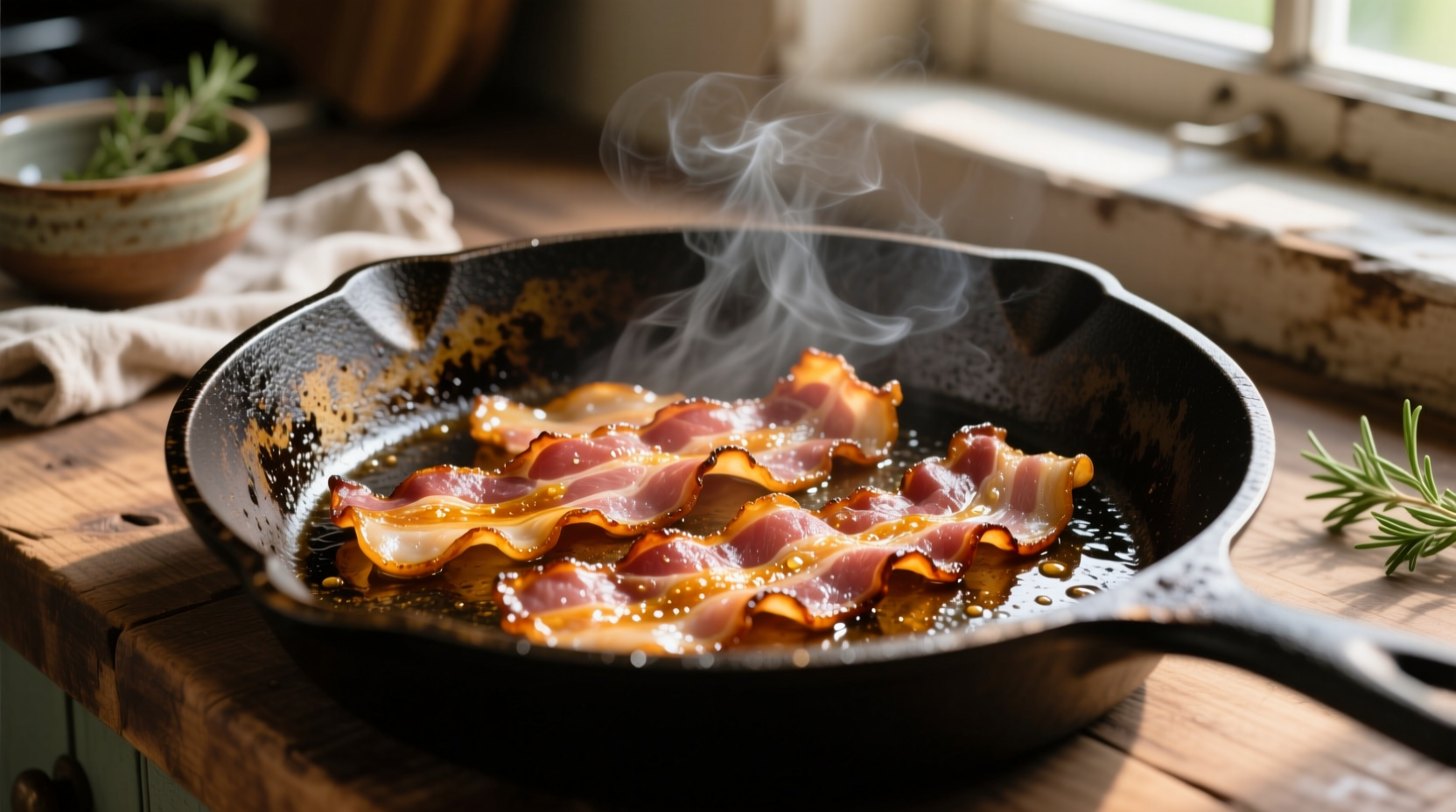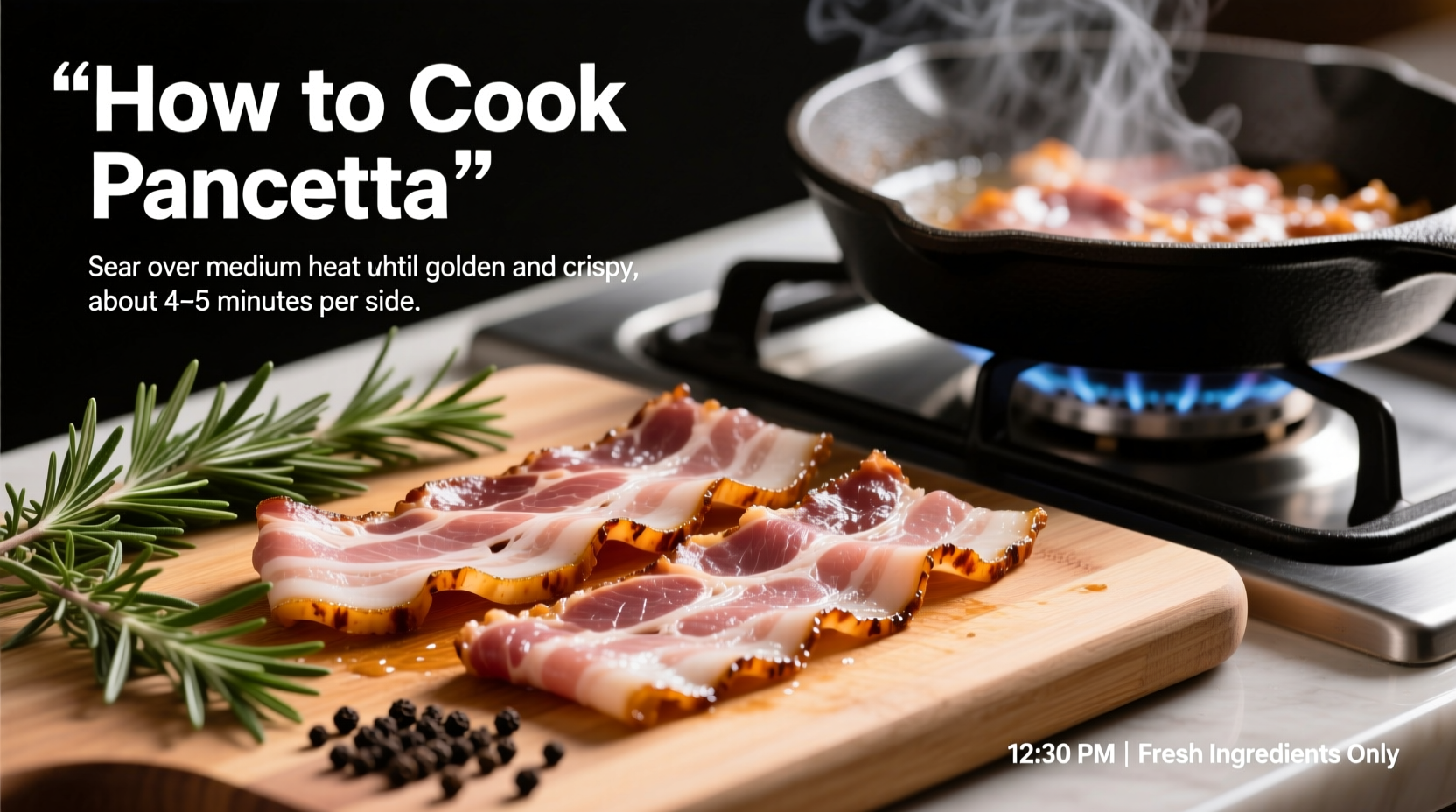Cook pancetta by pan-frying 1/4-inch thick slices over medium-low heat for 5-8 minutes until crispy, flipping occasionally. The key is slow rendering to avoid burning - never start with high heat. Drain on paper towels before using in pasta, salads, or as a flavor base for sauces.

Master Pancetta Cooking: From Raw to Perfectly Crispy
Many home cooks struggle with pancetta, burning it or ending up with rubbery results. The secret lies in understanding this Italian cured pork belly's unique properties and cooking it with patience. Unlike bacon, pancetta contains no smoke flavoring and has a higher fat content that requires careful temperature control for optimal results.
Understanding Pancetta Before You Cook
Pancetta is Italian cured pork belly, typically seasoned with black pepper, garlic, and sometimes herbs like rosemary or juniper berries. Unlike American bacon, it's never smoked, giving it a cleaner pork flavor that shines in classic Italian dishes. There are two main types you'll encounter:
| Type | Characteristics | Best Cooking Method |
|---|---|---|
| Pancetta Tesa (Flat) | Sliceable, rectangular shape, consistent thickness | Ideal for dicing and rendering into sauces |
| Pancetta Arrotolata (Rolled) | Round, rolled shape with visible layers | Best for slicing thin and pan-frying until crisp |
Essential Preparation Steps
Before cooking, proper preparation ensures optimal results. USDA Food Safety guidelines recommend keeping cured meats refrigerated below 40°F (4°C) until ready to use. When handling pancetta:
- Slice thickness matters: For crispy applications, cut 1/4-inch thick slices. For dicing into sauces, 1/8-inch works best
- Pat dry: Remove excess moisture with paper towels to promote even browning
- Bring to cool room temperature: Let sit 15 minutes before cooking for more even rendering
- Use the right pan: Cast iron provides superior heat retention for consistent cooking
Perfect Pan-Frying Technique: Step by Step
This method produces the classic crispy pancetta perfect for topping salads or pasta. Professional chefs at the Culinary Institute of America emphasize starting with a cold pan to properly render the fat:
- Place pancetta slices in a cold cast iron skillet in a single layer (don't overcrowd)
- Set burner to medium-low heat (300-325°F / 150-160°C)
- Cook undisturbed for 2 minutes to allow initial rendering
- Flip slices and continue cooking 5-8 minutes total, flipping occasionally
- Remove when golden brown and crispy (not blackened)
- Transfer to paper towels to drain excess fat
Resist the urge to increase heat - rushing causes uneven cooking where the fat burns before the meat crisps. Save the rendered fat (called strutto) for cooking vegetables or eggs; it's a traditional Italian flavor booster.
Baking Method for Large Batches
When cooking larger quantities, baking produces more consistent results with less hands-on time. According to Italian culinary tradition documented by the Accademia Italiana della Cucina, this method mimics how nonnas prepare pancetta for Sunday pasta sauces:
- Preheat oven to 375°F (190°C)
- Arrange slices on wire rack set over baking sheet
- Bake 15-20 minutes until edges curl and become golden
- Rotate pan halfway through for even cooking
- Drain on paper towels immediately after removing
This technique works particularly well for pancetta arrotolata that you've sliced thin. The elevated rack allows air circulation for even crisping without soggy spots.
Culinary Applications: Beyond Simple Crisping
Cooked pancetta serves multiple functions in Italian cuisine. Understanding these applications helps you maximize its potential:
- Flavor base: Dice and render slowly to create the foundation for sauces like Amatriciana
- Crispy garnish: Thinly sliced and fully crisped for salads, soups, or pasta toppings
- Wrapped proteins: Use thin slices to wrap fish or poultry before roasting
- Infused fat: Save rendered fat for cooking vegetables or making dressings
For best results in sauces, professional chefs recommend rendering diced pancetta until the fat is mostly extracted but the cubes still hold their shape - this provides maximum flavor without overwhelming oiliness.
Avoiding Common Pancetta Mistakes
Even experienced cooks make these pancetta errors. Recognizing these pitfalls ensures perfect results every time:
- Starting with high heat: Causes exterior burning before interior renders properly
- Overcrowding the pan: Creates steam that prevents crisping (cook in batches)
- Not saving the fat: Wasting this flavorful cooking medium diminishes overall dish quality
- Using as direct bacon substitute: Pancetta's unsmoked flavor requires different pairing considerations
Food science explains why patience matters: pancetta's high fat content needs time to render slowly. Rushing this process through high heat causes the proteins to seize up before the fat can properly liquefy, resulting in chewy, unevenly cooked pieces.
Storage Guidelines for Cooked and Uncooked Pancetta
Proper storage extends pancetta's shelf life while maintaining quality. The USDA Food Safety and Inspection Service recommends:
- Uncooked pancetta: Keep refrigerated below 40°F (4°C) in original packaging until ready to use. Once opened, wrap tightly in parchment paper followed by plastic wrap.
- Cooked pancetta: Store in airtight container with a paper towel to absorb excess moisture. Consume within 4 days.
- Rendered fat: Strain through cheesecloth and store in glass jar in refrigerator up to 6 weeks.
For long-term storage, freeze uncooked pancetta in vacuum-sealed packages for up to 3 months. Thaw in refrigerator before cooking - never at room temperature.
When to Choose Pancetta Over Bacon
Understanding the context boundaries helps you select the right cured pork for your dish. While interchangeable in some applications, each has ideal uses:
- Use pancetta when: Making authentic Italian dishes, creating subtle pork flavor without smoke, or needing clean pork notes to complement delicate ingredients
- Use bacon when: You want smoky flavor, making breakfast dishes, or creating bold flavor contrasts in salads or desserts
Traditional Italian chefs never use bacon in pasta carbonara - the smokiness fundamentally changes the dish's character. Pancetta's pure pork flavor allows the egg and cheese to shine through.











 浙公网安备
33010002000092号
浙公网安备
33010002000092号 浙B2-20120091-4
浙B2-20120091-4